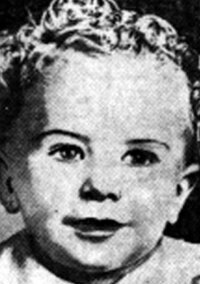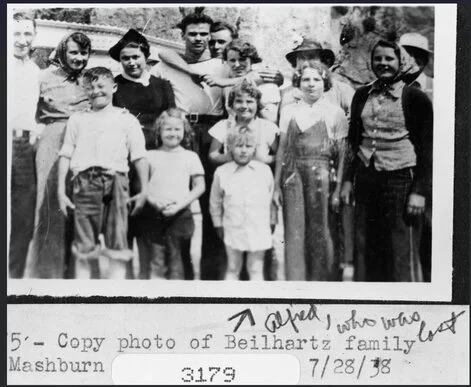The strange disappearance of Alfred Beilhartz in Rocky Mountain National Park
Alfred Edwin Beilhartz, disappeared July 3, 1938, Near Estes Park, Rocky Mountain National Park, Colorado.
Revised January 2024
On July 3, 1938, the Beilhartz family took advantage of the Independence Day weekend to go camping in Colorado’s Rocky Mountain National Park. Their four-year-old son, Alfred Edwin Beilhartz, was to vanish that day, and to this day, no sign of the young boy has turned up.
There were several strange reports of Alfred, including on top of a rocky, inaccessible outcrop called Devil’s Nest, near Mount Chapin, 6 miles from where he vanished. He was also reported in the company of a mysterious man on a road in the area.
The family and their father, William Harvey, who included ten children, lived at 3225 Quebec Street in Denver, Colorado.
The Beilhartz family and some friends set up camp roughly a quarter mile west of the Fall River Lodge. It was located just south of the west exit of the current Lawn Lake Trailhead parking lot. The camping party was near where the Roaring and Fall Rivers met, just below Horseshoe Falls.
The family woke bright and early that morning. William Beilhartz, Alfred’s father, decided to walk to the nearby stream to wash up, and Alfred came along. Oran Bronson and Walter Hansen, friends of the Beilhartz family, had also set out to freshen up roughly 500 feet upstream from Alfred and William. William and Alfred finished their wash before Oran, Walter, and William returned to camp. Alfred walked upstream to follow Oran and Walter once they were finished.
Once Oran and Walter returned to camp, the group noticed Alfred was not with them. He had gone missing between when William returned to camp, and Oran and Walter returned.
About Rocky Mountain National Park and Roaring River
Rocky Mountain National Park is an American national park located approximately 76 mi (122 km) northwest of Denver International Airport in north-central Colorado, within the Front Range of the Rocky Mountains. The park is situated between the towns of Estes Park to the east and Grand Lake to the west. The eastern and western slopes of the Continental Divide run directly through the center of the park, with the headwaters of the Colorado River located in the park's northwestern region.
The Rocky Mountain National Park Act was signed by President Woodrow Wilson on January 26, 1915, establishing the park boundaries and protecting the area for future generations.
The hike to Lawn Lake in Rocky Mountain National Park begins from the Lawn Lake Trailhead in the Horseshoe Park area just west of Estes Park. The trail climbs steadily through a relatively dense mixed pine forest from the start.
Roaring River
Just over a mile from the trailhead, hikers will reach the steep banks of the Roaring River, where some of the destruction from the infamous Lawn Lake Flood can be seen. In 1903, a 26-foot high earthen dam was built to enhance the natural lake from 16.4 acres to 48 acres to help with crop irrigation in the Loveland area. On July 15, 1982, the dam failed and released more than 300 million gallons of water down the Roaring River valley. Some witnesses said the failure created a wall of water 25 to 30 feet high. After killing three campers, the water rushed down Elkhorn Avenue in Estes Park before stopping at Lake Estes.
The search for Alfred Edwin Beilhartz
The campers began searching for Alfred immediately. Over a dozen individuals were at the campsite, and they were convinced they would find him quickly. He couldn’t have gotten far in such a short amount of time. Plus, it would be difficult for Alfred not to hear over a dozen people shouting his name and follow their voices back to safety. But, after scouring the area and not finding Alfred, the family became very anxious about Alfred’s whereabouts.
When they had no luck, they decided to call the park service for assistance. The Beilhartz family contacted Ranger Moomaw at the Fall River Ranger Station. Ranger Moomaw immediately involved the CCC (Civilian Conservation Corps), a work relief program created as part of Roosevelt’s New Deal, to help the search effort. Within 45 minutes, over 100 CCC members had arrived to begin searching.
On Monday, July 4th, Independence Day, CCC and other volunteers were still combing the area for any sign of Alfred and Bloodhounds from the Colorado State Prison were brought into the park to help aid the search. But they were unable to find Alfred’s scent.
The rangers were operating under the assumption that Alfred may have fallen into the nearby Roaring River and drowned, so they decided to dam and divert the river on July 5. The search party built a dam with sandbags, rocks, and logs and used grappling hooks and pikes to search the riverbed. Despite their efforts, nothing was found in the diverted riverbed, so they erected a wire net near the Fall River to catch any evidence. When this returned no results, they gave up searching the river.
His parents told the rangers that they were sure that he must have been abducted. They knew their son wouldn't leave his family and were sceptical that he had just fallen into the water.
By Wednesday, July 6th, the search of the river had ended, leaving searchers frustrated and confused. They continued to search the land, and by Thursday, 200 searchers told news reporters they were convinced he had never drowned and had either gotten lost in the forest or was kidnapped.
The searchers were convinced that if the boy had fallen into the Roaring River, his body could not have passed all five of the beaver dams and reached the Fall River. Even if it had, they said, it could not have passed a wire net set up near the water by workers for the public service company of Colorado.
Rangers called in some sniffer dogs from the nearby Colorado State Penitentiary. A human scent was detected, but the hounds stopped near the river. Another set of dogs hit on a scent some way higher in elevation from the camp but led nowhere.
The search was eventually called off after ten days.
The Devil's Nest sighting, Bandage and the Mystery Man
On Sunday, July 3rd, William J. Eells, a radio appliance employee from Denver, and his wife were hiking in the Rocky Mountains National Park.
They had made it quite far up the Old Fall River road when they got tired and decided to stop for a rest. While resting around 1 pm, they decided to look up to Mount Chapin and were shocked to see a young boy sitting on a rock in a section of the mountainside known as the Devil's Nest. This was around six miles west of where Alfred Beilhartz had disappeared.
The child was said to have made a “shrill noise'“they walked out to look over the ledge and then either left or was pulled from it.
They decided to hike to the point where they saw him to ensure the child was safe. But when they reached the boulder he was perched upon, they found nothing. The pair decided to alert someone about a child roaming around on the Devil’s Nest.
The Eells returned to their parked car and heard the news of the missing boy on the radio. Upon returning home, the couple checked the newspaper and confirmed that the photograph of Alfred Beilhartz within it matched the child they had seen in the Devil's Nest. They promptly drove back to the park and contacted rangers.
However, the rangers were skeptical, believing it would have been impossible for Alfred to have made his way up to the slope to Devil’s Nest. They eventually sent over 150 men to search the area, but they came back empty-handed.
On July 8th, the FBI announced that it was performing forensic tests on a piece of '“soiled” bandage that had been found in an abandoned cabin in the park. The disclosure of this finding was prompted by the insistence of the boy's parents that their son must have been abducted. Alfred had a blister on his foot when he had vanished, and his mother had bandaged it using a similar material.
On this same day, Mrs. CA Linch, who lived in Big Spring, Nebraska, allegedly saw Alfred and a mysterious man walking along a highway together as she and her husband drove from Big Spring to Ogallala.
She didn’t know until the following day how important her sighting was when she was reading the newspaper and saw the photo of Alfred. She claimed the boy she saw on the highway was the same boy, and she was adamant it was him.
She told her brother-in-law, WB Linch (of Lincoln, Nebraska), about her sighting, and he then went to speak to a Denver detective sergeant by the name of Fred Renovati two days later on behalf of his sister-in-law. He said that she was positive the boy was the one whose picture she saw.
Ransom demand for Alfred Beilhartz
On Sunday, November 27, 1938, when Alfred Beilhartz had been missing for five months, his father was sent a ransom note.
The message said, “Sorry for your son. We went west out of money. The boy doesn’t take to us. We will return your son if you leave $500 in a can one block from your house and the note. We will return your son within 24 hours.”
However, by November 29th, the police were pretty sure that this was a hoax, and the next day, they confirmed they had investigated two possible suspects. They were not named and were not formally charged. The line of inquiry quickly ended for reasons unknown.
What happened to Alfred Beilhartz?
Drowned in the river - The Roaring and Fall Rivers were well searched. Perhaps he was missed?
Abducted - The family always believed that Alfred was taken. Was the ransom demand genuine? If so, was the sighting on Devil’s Nest on Sunday, July 3rd, by William J. Eells and his wife mistaken? Did they hear and see an animal instead of a boy? How could a 4-year-old hike thousands of feet in only a few hours?
Foul play - Was the boy accidentally killed by the family, and the evidence covered up? Did an unknown predator kill Alfred?
Exclusive articles for members of StrangeOutdoors that are not available elsewhere on the site.
See the latest Exclusive members-only articles on StrangeOutdoors.com
Read other strange stories from Colorado
The death of Peter Jeffris in the Rocky Mountains (Member Only)
The mysterious disappearance and death of Doctor James McGrogan in Colorado
The strange disappearance and death of Gene George from Mount Harvard
The mysterious disappearance of Michelle Vanek on the Mount of the Holy Cross
The bizarre disappearance of Keith Reinhard and death of Tom Young in the Rocky Mountains
Michael and Makana Von Gortler’s unexplained deaths on Missouri Mountain
The Strange disappearance of Maurice "Doc" Dametz
The disturbing death of 3 year old Jaryd Atadero on the Big South Trail
The unexplained disappearance and death of Mitchell Dale Stehling in Mesa Verde National Park
The weird disappearance of hunter Alvie Webb in the San Juan National Forest
The strange death of Joshua Maddux, the Boy in the Chimney
Sources
http://charleyproject.org/case/alfred-beilhartz
https://paranormal-world.fandom.com/wiki/The_Vanishing_of_Alfred_Beilhartz
https://en.wikipedia.org/wiki/Rocky_Mountain_National_Par
https://echoespath.com/alfred-beilhartz/
Further listening




